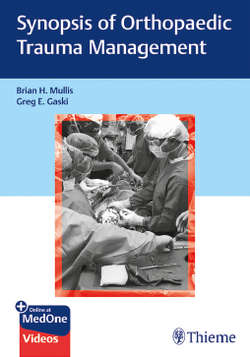Читать книгу Synopsis of Orthopaedic Trauma Management - Brian H. Mullis - Страница 24
На сайте Литреса книга снята с продажи.
IV. Surgical Management of Open Fractures
ОглавлениеA. Goals of debridement
1. Open fractures are contaminated. Consider the level of contamination, severity of the wound, and the health of the patient when determining the risk of infection.
2. Timing of surgical debridement:
a. A recent meta-analysis found no difference between debridements performed before and after 12 hours from time of injury.
b. Data from the LEAP study found no difference in timing of debridement; however, timing of arrival to the definitive treatment center was correlated with infection.
c. It is recommended that open fractures should undergo surgical irrigation and debridement within the first 24 hours after injury when the patient is appropriately resuscitated and medically optimized for surgery, but this time point is based mostly on expert opinion. There may be open fractures where more urgent debridement is necessary such as associated vascular injuries or grossly contaminated wounds.
3. Surgical approach:
a. Removal of all devitalized and contaminated tissue to minimize infection.
b. Excision of bone fragments devoid of soft tissue attachment except when that bone has significant portions of the joint attached to it.
c. There is wide variation among surgeons regarding the extent of osseous debridement necessary. For example, aggressive debridements may reduce the risk of infection, but large bone defects create challenges with initial limb stabilization and may be associated with more complex reconstructive paths to achieve healing.
B. Irrigation
1. Types and application:
a. Purpose of irrigation is to help create a clean healing base by decreasing bacterial load, removing foreign bodies and detached necrotic tissue.
b. It should be performed after complete surgical debridement.
c. Normal saline is the most commonly used irrigant with poor support for other adjuvants to the solution.
d. Irrigant may be administered in a low-pressure manner by saline bags passing through cystoscopy tubing by gravity.
e. High-pressure irrigation is an alternative form with increased irrigant velocity thought to enhance debridement. Potential disadvantages outlined in basic science studies suggest an additional insult to bone and soft tissue, and concern for propulsion of bacteria deeper into tissues.
f. FLOW study: level 1 multicenter study comparing irrigation types in open fractures.
i. No clinical difference in reoperation rates between high-pressure, low-pressure, and gravity-rate irrigation.
ii. Higher reoperation rates in patients randomized to soap irrigation compared to saline.
C. Fracture stabilization
1. External fixation:
a. It provides preliminary temporary skeletal stabilization in an expeditious manner or it can be used as definitive fixation. This is important not only to stabilize the bone but may also help in stabilizing the soft-tissue injury.
b. Soft-tissue injury can make pin placement difficult. Pins can be placed either at a distance from the wound or directly in the wound depending on size and morphology.
c. Consider for severe trauma/polytrauma, associated vascular injury, and highly contaminated open injuries that may require multiple surgical debridements.
d. External fixation is often advantageous in these situations as it is easy to obtain full access to the wound by displacing the bones which is more difficult to do once internal fixation is in place.
2. Internal fixation:
a. Performed after debridement and irrigation is complete.
b. May be performed in the same surgical setting after debridement for open fractures that have a low likelihood for persistent contamination and infection.
c. Many surgeons prefer to limit the time between definitive fixation and flap coverage, and recent data supports that longer times (7 days or more) between fixation and flap coverage are associated with higher infection rates.
d. Temporary internal fixation, known as “damage-control plating,” has recently been described as an effective means to stabilize open fractures prior to repeat surgical debridement with significantly lower costs (25%) incurred.
D. Infection prevention: local antibiotic delivery
1. Antibiotic bead placement:
a. This serves as an easily retrievable method for high-dose local antibiotic delivery to prevent infection although there is little data looking at their use (▶Fig. 2.2).
Fig. 2.2 An example of an open distal tibia fracture with bone loss and gross contamination being treated with antibiotic beads fabricated by polymethylmethacrylate combined with antibiotic powder.
b. Antibiotic powder is combined with polymethylmethacrylate cement and shaped into beads.
c. Vancomycin and tobramycin are commonly used although other heatstable options exist.
d. Capable of delivering very high local antibiotic concentrations and avoid the potential systemic antibiotic side effects.
e. Beads are typically strung onto wire or suture to keep them localized in the wound and are often removed at the time of final wound closure.
2. Antibiotic spacer placement:
a. Composition similar to that of antibiotic beads.
b. Administered in the form of a cement block.
c. In addition to providing high concentrations of local antibiotic delivery, this technique, when placed into a bone void can provide additional skeletal stability.
3. Antimicrobial implants:
a. Antibiotic cement may be used to coat orthopaedic implants when infection risk is high. Some implants exist with antimicrobial coatings but their clinical impact is unknown.
E. Indications for serial debridement
1. Intraoperative findings during the initial debridement dictate the need for subsequent debridement.
2. High levels of contamination and tissue nonviability will necessitate repeat surgical debridements (▶Fig. 2.3) as these wounds often evolve and more necrotic tissue will be observed at subsequent debridements.
Fig. 2.3 Large open and grossly contaminated wounds typically require multiple surgical debridements.
